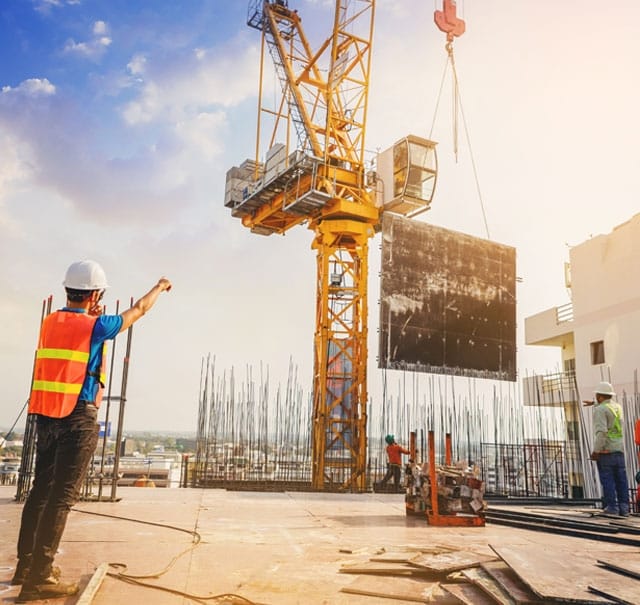Geolocation via LoRaWAN
Requirements for transparency, robustness and durability covered by one technology
LoRaWAN
LoRaWAN in the Construction Industry
The implementation of construction projects requires large quantities of electricity, water and building materials as well as a large number of employees. The lack of clarity on (large) construction sites makes it difficult to monitor and protect equipment and machinery against theft.
How can requirements for transparency, robustness and durability be covered by one technology? The ranges of passive technologies, for example RFID, are too short. GPS does not penetrate the entire interior space. Mobile phone applications generate network usage costs and offer additional services that are not required, including large bandwidths and high data transmission speeds.
One technology that addresses all requirements without driving up infrastructure costs is LoRaWAN. This low-power wide-area network offers an open, global, interoperable standard. The investment in hardware infrastructure is low compared to other wireless technologies. The sensors ensure battery runtimes of over ten years, depending on the frequency of information retrieval. For construction site applications, low latencies combined with large data packets play a secondary role.
LoRaWAN-Based Application Examples on the Construction Site
- Geolocation and tracking of equipment, construction materials/load carriers and personnel
- Optimized utilization and condition monitoring of construction vehicles and machines
- Predictive maintenance plans based on captured data such as mileage, engine hours, energy consumption and idle time
- Acquisition of measurement data such as temperatures, humidity or vibration from the construction
- Collision avoidance and detection of construction vehicles
- Indoor and outdoor air pollution and quality monitoring
- Monitoring of safety zones for equipment and workers (geofencing)
- Capture of energy and water consumption
Why LoRaWAN on the Construction Site?
LoRaWAN operates in unlicensed frequency bands that can be used free of charge. Communication takes place in regionally different frequency ranges in the ISM and SRD bands – in Europe, for example, in the ranges 433.05 to 434.79 and 863 to 870 MHz.
The technology combines the features of cellular and Wi-Fi connectivity – long range, secure communications and high indoor performance – with long battery life for the end devices. LoRaWAN offers the construction industry the possibility to integrate different tracking, localization or sensor data collection solutions.

Tracking, localization or sensor data capture can be exchanged over long distances via LoRaWAN.
LoRaWAN
LoRaWAN in the Construction Industry
The implementation of construction projects requires large quantities of electricity, water and building materials as well as a large number of employees. The lack of clarity on (large) construction sites makes it difficult to monitor and protect equipment and machinery against theft.
How can requirements for transparency, robustness and durability be covered by one technology? The ranges of passive technologies, for example RFID, are too short. GPS does not penetrate the entire interior space. Mobile phone applications generate network usage costs and offer additional services that are not required, including large bandwidths and high data transmission speeds.
One technology that addresses all requirements without driving up infrastructure costs is LoRaWAN. This low-power wide-area network offers an open, global, interoperable standard. The investment in hardware infrastructure is low compared to other wireless technologies.
The sensors ensure battery runtimes of over ten years, depending on the frequency of information retrieval. For construction site applications, low latencies combined with large data packets play a secondary role.
LoRaWAN-Based Application Examples on the Construction Site
- Geolocation and tracking of equipment, construction materials/load carriers and personnel
- Optimized utilization and condition monitoring of construction vehicles and machines
- Predictive maintenance plans based on captured data such as mileage, engine hours, energy consumption and idle time
- Acquisition of measurement data such as temperatures, humidity or vibration from the construction
- Collision avoidance and detection of construction vehicles
- Indoor and outdoor air pollution and quality monitoring
- Monitoring of safety zones for equipment and workers (geofencing)
- Capture of energy and water consumption

Tracking, localization or sensor data capture can be exchanged over long distances via LoRaWAN.
Why LoRaWAN on the Construction Site?
LoRaWAN operates in unlicensed frequency bands that can be used free of charge. Communication takes place in regionally different frequency ranges in the ISM and SRD bands – in Europe, for example, in the ranges 433.05 to 434.79 and 863 to 870 MHz.
The technology combines the features of cellular and Wi-Fi connectivity – long range, secure communications and high indoor performance – with long battery life for the end devices. LoRaWAN offers the construction industry the possibility to integrate different tracking, localization or sensor data collection solutions.





